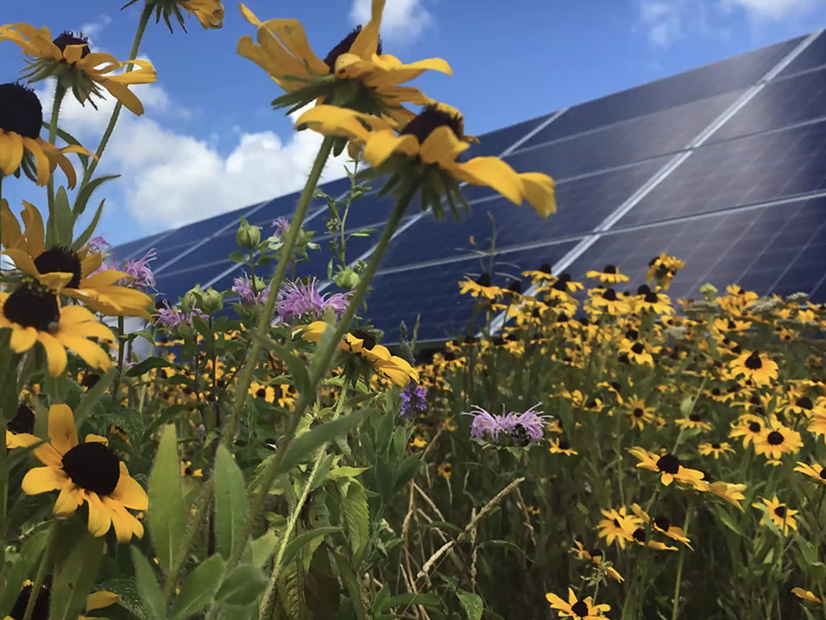
Saving the bees may not be the focus of many utility-scale solar developers. But a group of Minnesota ecologists say developers should embrace “pollinator-friendly” projects to address the concerns of farmers who may regard solar panels as an invasive technology rather than a value-added crop.
Planting regional wildflowers and native grasses rather than turf grass under solar panels adds carbon to the soil, they say, and can feed bees established on the perimeter of a solar farm. In addition to producing a honey crop, the bees also pollinate nearby crop fields, increasing production, according to early research results.
The grasses can also serve as forage for periodic sheep grazing that eliminates the need for mowing, significantly reducing the risk of grass fires and eliminating the chance of damage to solar arrays by mowing equipment, advocates say. And the sheep’s hooves prepare the land for new growth, unlike mowing.
Researchers say the practice also reduces erosion and improves groundwater recharge. Small power generation increases have been seen as well, at least in some climates.
The novel approach to solar began in 2010 as an experiment at a National Renewable Energy Laboratory (NREL) in Colorado. Today, agrivoltaics — or “low impact solar” because it usually does not involve stripping off the topsoil during construction — is part of a strategy to make solar more amenable to farmers considering leasing their land.
The Minnesota Agricultural Utilization Research Institute (AURI), a nonprofit created by the state legislature, took a look at the practice in a recent webinar focusing both on the impact of sheep grazing and the creation of what could be a new agricultural business: solar honey. AURI’s mission is “to foster long-term economic benefit for Minnesota through value-added agricultural products.”
Solar ‘Another Specialty Crop’

“Solar is really just another specialty crop, [and] even by the most ambitious planning and forecasting, [the U.S. will have] something like 9 million acres of solar by 2050. We have 90 million acres of corn in the United States today. Solar is never going to supplant all the corn; never going to supplant all the soybeans. But it will always have an opportunity to be a kind of a nice crop for value-added producers,” said Davis, now spokesman for cooperative Connexus Energy. “The experts we have assembled today each have a different perspective on what is feasible and practical and what benefits their business [and] how they’re embracing these new landscapes.”
Jake Janski, senior ecologist at MNL, a private ecological services company about 30 miles northwest of Minneapolis, said the company incorporated grazing services into its ecosystem management services about five years ago.
“The most successful application that we have found for our grazing program is the use of sheep on these pollinator friendly solar sites,” he said. “We’re working with eight different solar companies on their individual portfolios to implement our grazing program.

Dustin Vanasse, founder and CEO of Minneapolis-based Bare Honey, has grown the business thanks to pollinator-friendly solar.
“Coming into 2022, we will have almost 100% of our hives on solar. It’s taken us kind of baby steps to work our way in. We also work with another network of beekeepers and subcontract for their placement of hives on solar farms. This is how we’re developing our expansion,” he said. In addition to offering honey to consumers, the company sells it to food manufacturers in “40-lb. buckets or 55-gallon drums.”
Minn. Legislative Action
After a 2014 experiment with wildflowers by Minnesota researchers, the state legislature approved a bill in 2016 encouraging the planting of “flowering meadows” in and around solar developments to combat the alarming decline of honeybee populations, explained Davis.
The legislation, based on initial efforts of Fresh Energy, Audubon Minnesota, and the Minnesota Corn Growers, led to the development of a standard for vegetation that the PUC can now require on solar sites.

Regulators working with advocates developed a “pollinator habitat assessment” to determine just how pollinator friendly a proposed solar development will be.
The new standards and underlying research have led to a kind of symbiotic relationship between solar technology and agriculture. The payoff is that crops as well as wildflowers and native grasses are more vigorous, the soil less damaged and solar systems less expensive to maintain, advocates say.
Other States
Minnesota’s model has since been adopted by Illinois, Maryland, Michigan, New York, South Carolina and Vermont, according to the Clean Energy State Alliance. Projects in some states have found that building the solar arrays taller, which adds cost to the project, creates a cooler environment and increased production of vegetable crops that do not need full sunlight and benefit from the cooler temperatures and soil that is not dried out by the direct sun.
The movement has also caught the attention of the Department of Energy, which has created a program, Innovative Site Preparation and Impact Reductions on the Environment (InSPIRE), to help the solar industry, universities and state organizations conduct research. InSPIRE is involved in more than a dozen states, including Minnesota.
Davis said NREL is doing a study in Minnesota comparing the power output at the inverter level on solar arrays located on vegetated sites versus bare sites.
The Yale Center for Business issued a preliminary report in 2019 noting that the addition of perennial grasses and flowers to solar fields appeared to create a cooler micro climate, resulting in increased electrical generation from the solar array. The study also noted that the grasses reduced soil erosion and helped with groundwater recharge.
The University of Arizona has also been researching the impact of food crops under and around solar arrays and has calculated the increase in power generation as well as an increase in soil moisture and plant production.
“Across the core growing season, PV panels in an agrivoltaic system were about 8.9 degrees C cooler (16 degrees F) in daylight hours,” researcher Greg Barron-Gafford, a professor at the university’s School of Geography, in Tucson, said in an email. “This reduction in temperature can lead to an increase in system performance. Using the system advisor model (SAM) for a traditional and a co-location PV system in Tucson, we calculated that temperature reductions documented here in the growing months of May–July from the colocation system led to a 3% increase in generation over those months, and a 1% increase in generation annually.”
Davis urged farmers who have been approached by solar developers to ask for “regenerative practices” such as pollinator friendly flowers or grazing grasses when solar developers approach them. “Put it in the contract,” he said.
“This idea of pollinator friendly solar is not a restoration of some pre-colonial condition. It’s accepting that solar is happening and is looking for ways to provide meaningful benefits to the soil, to the pollinators and to the ecosystems within that managed context.”

